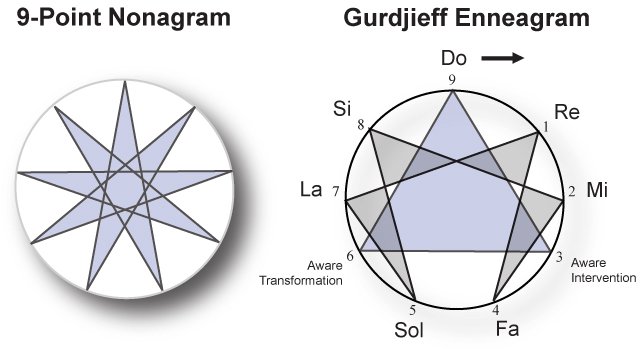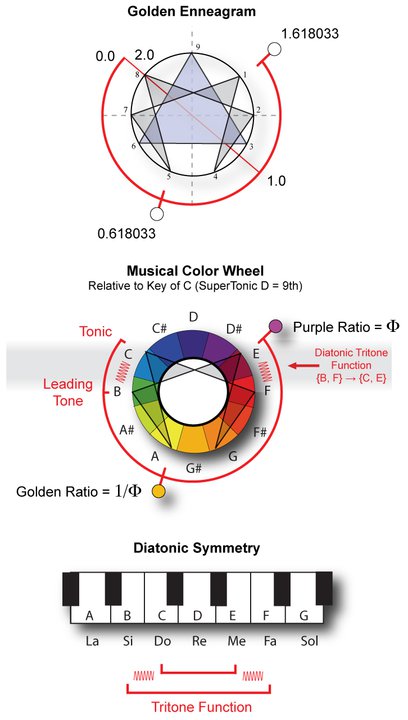The Golden Enneagram
The Enneagram is a nine-pointed star polygon, also known as a nonagram, that is often associated with certain esoteric and mystical qualities. First introduced to the West by George Gurdjieff, a Greek-Armenian mystic and spiritual teacher, it was the symbol of universal harmony used in his Institute for the Harmonious Development of Man and what later became known as The Fourth Way school.

Gurdjieff learned of the Enneagram from a secret brotherhood of Sufis called the Naqshbandi. While some suggest the Enneagram is no older than the 14th or 15th century, its origin likely extends much further back in time to the mythology of King Ninus (and Queen Semiramis) said to have founded the ancient Assyrian city of Nineveh. The number 9 has a long history of symbolisms in both Western and Eastern religions, repeated even into today’s pop culture by rock band Nine Inch Nails and the Beatles song Revolution 9.
Gurdjieff argued that many of the religious and spiritual traditions of human history had forgotten their original meaning, so no longer served humanity as originally intended. As a result humans were failing to understand the truth of ancient teachings and becoming more like automatons, susceptible to social control and mass psychosis. He saw the Enneagram as a model that could be used in many ways to understand and reconnect with the natural world.
Some of his followers developed the Enneagram into a model for analyzing human personality and enhancing consciousness. Bolivian Oscar Ichazo is generally recognized as the creator of the ‘Enneagram of Personality,’ which assigns a Characteristic Role, Virtue and other personality qualities to each of nine points. The goal of the system then is to progress around the Enneagram circle, overcoming points of change to achieve enlightenment and spiritual self-awareness.
The interesting thing about this version of the Enneagram is it is usually composed of an equilateral triangle superimposed on an irregular hexagram, thus forming an irregular nonagram. By separating the triangular group from the remaining six, the points of change called ‘Aware Intervention’ and ‘Aware Transformation’ are emphasized. Gurdjieff saw this as a 7-step musical Do-Re-Me scale where Do starts at the top and is counterbalanced by the two points of change and advancement.
As a researcher and writer on the subject of harmonic science, the thing that caught my attention was how the musical tones were positioned on the Enneagram. Specifically, I wondered why the tonic ‘Do’ was positioned at the top and symmetrical middle of the Enneagram when the actual point of scalar symmetry in a major scale is not Do but Re – the so-called ‘Supertonic.’ This is especially odd considering the Supertonic is also the ninth step in a diatonic scale and corresponds to the ninth wave partial in the harmonic overtone series. In fact, only the ninth is synchronized perfectly with ALL points of maximum resonance and damping in the tonic Do fundamental, thus making it a kind of central axis around which all the other harmonics balance. Why wasn’t the Enneagram centered around the ninth, I wondered?
[ NOTE: A formal proof for this can be found in my book INTERFERENCE, downloadable free from my website. ]
After further research and much deliberation, I came to the conclusion that the wrong musical mapping had been applied to the Enneagram (perhaps by Gurdjieff himself) and that it should be corrected to make it compatible with harmonic physics. Below is a diagram showing this new mapping centered on the Supertonic or Ninth and how this change also allows it to fit Isaac Newton’s color wheel centered on Indigo.
This new mapping reveals a couple of other very important features of the Enneagram. For one thing, it demonstrates how the irregular Enneagram used by Gurdjieff actually approximates golden means in the color wheel as measured from the relocated tonic (Do), a feature I’ve not seen described elsewhere. It also shows how relative to the Key of C major the tense ‘diatonic tritone’ interval {B, F} now balances symmetrically on the Enneagram, resolving symmetrically inward to the restful tonic major third {C, E}. In this way, the Enneagram can simultaneously represent harmony in geometry, music, tone and color.
Practitioners of the traditional Gurdjieff Enneagram need not take alarm from this revision. Rather, the teachings associated with the Enneagram can now be taken to reflect the actual physics intrinsic to all harmonic vibration. With this new mapping, the symmetry of the Enneagram now mirrors the symmetry of the diatonic scale and even the symmetry of a piano keyboard. And as a fitting tribute to its most ancient origin, the ninth Re – a possible allusion to the Egyptian sun god Amun Ra – can once again sit upon his resonant pyra-mid, the eternal ‘fire in the middle’ that rests inside the Enneagram.

Content courtesy of Richard Merrick
Copyright (c) 2011. All Rights Reserved.









